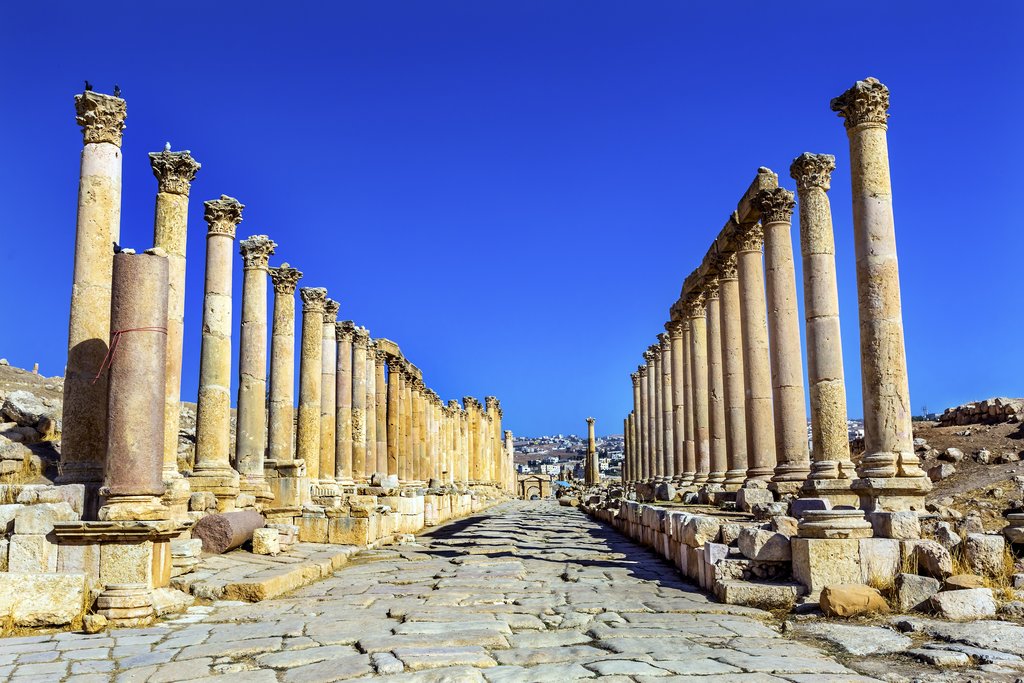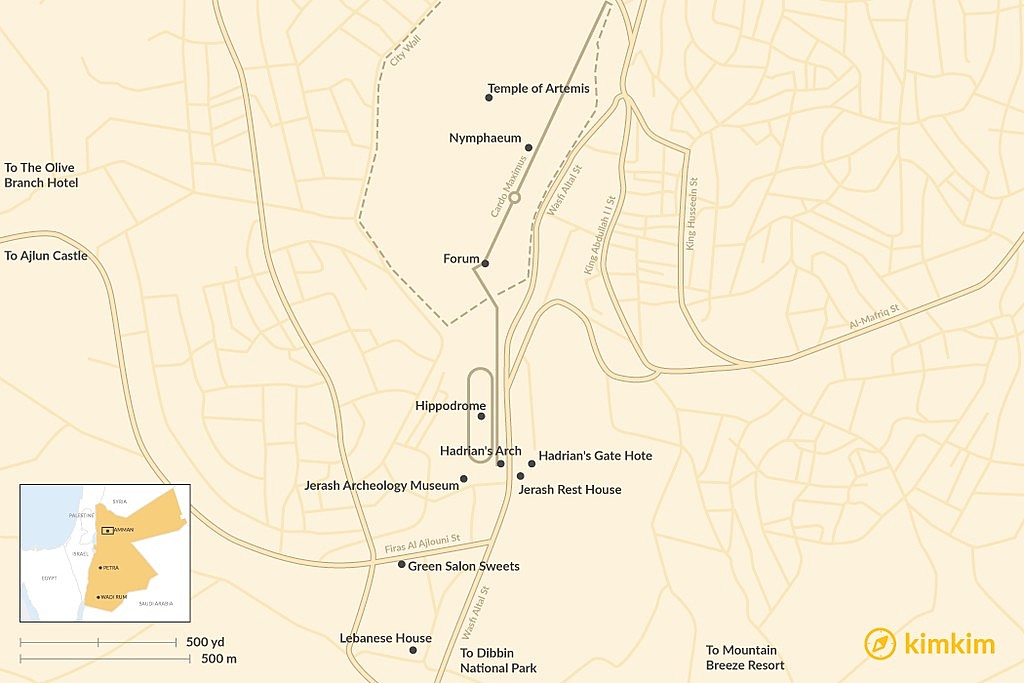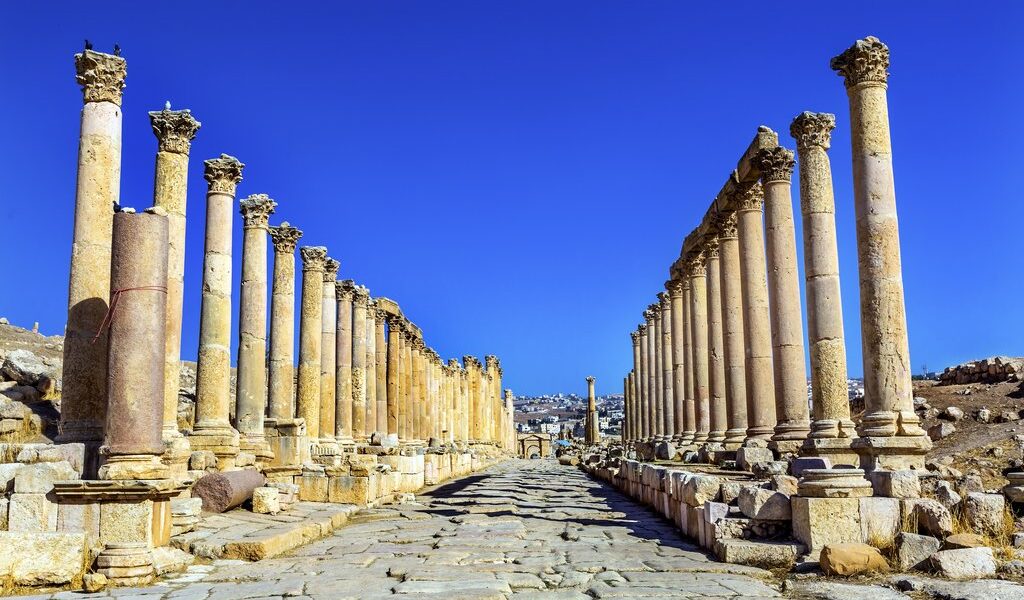
One of Jordan’s busiest and most powerful outposts in ancient times, Jerash is now renowned for its beautifully preserved sense of history. It may look small on a map, but it’s packed with archeological wonders and authentic local charm. Read on for our expert take on how to experience Jerash.
## Unveiling the Ancient Wonders of Jerash: A Journey Through Time
Jerash, a captivating city in northern Jordan, stands as a testament to the region’s rich history and enduring beauty. Often hailed as the “Pompeii of the Middle East,” Jerash draws visitors from across the globe, eager to explore its remarkably well-preserved Roman ruins. Nestled amidst fertile farmlands and gently undulating hills, this ancient metropolis lies a mere stone’s throw – less than fifty kilometers – from the vibrant capital city of Amman. This proximity renders Jerash an exceptionally popular destination for day trips, offering a convenient escape from the urban bustle and a step back in time.
Jerash owes much of its fame to the exquisite ruins that date back to the first century AD, a period that witnessed the city’s zenith under Roman dominion. The architectural remnants eloquently narrate the story of this bygone era, showcasing a profound Roman influence. As visitors meander through the sprawling site, they are greeted by a breathtaking panorama of majestic columns, expansive plazas, and awe-inspiring temples, all meticulously preserved to evoke the grandeur of the Roman Empire. These remarkable features have undeniably cemented Jerash’s position as a unique and invaluable historical landmark.
Beyond its archeological allure, modern Jerash presents a serene and tranquil atmosphere, its economy primarily sustained by agriculture. However, its strategic location renders it an ideal springboard for exploring the surrounding natural wonders and historical treasures that the region has to offer. Nature reserves brimming with biodiversity and other significant historical sites are easily accessible from Jerash, further enriching the visitor experience.
## Navigating the Historical Tapestry of Jerash
The ease of access to Jerash is a significant advantage for travelers. Situated less than an hour’s drive from Amman, Jerash seamlessly integrates into any comprehensive tour of Jordan. For those requiring transportation, securing a private driver for the day offers the most flexibility and potentially the best value. However, it is crucial to negotiate the price and clarify the inclusions before embarking on your journey.
The city itself is relatively compact, rendering it easily navigable. A river valley effectively divides Jerash into two distinct sections. The eastern side is predominantly a residential area, representing modern-day Jerash. However, the vast majority of visitors gravitate towards the western side, where the remarkably preserved ancient city lies. After passing through the iconic Hadrian’s Arch, visitors are immediately immersed in the heart of the archeological park, ready to embark on an unforgettable journey of discovery.
## Must-See Attractions Within Jerash
**The Hippodrome: A Stage for Ancient Spectacles:** Step into the Hippodrome, a colossal ancient sports arena capable of accommodating up to 15,000 spectators. This impressive venue continues to resonate with the echoes of the past, hosting captivating mock gladiator fights and exhilarating chariot races several times each week. Witness the reenactment of ancient spectacles that transport you back to the Roman era.
**Hadrian’s Arch: A Monument to Imperial Ambition:** Marvel at Hadrian’s Arch, a majestic gateway originally erected to honor the Roman Emperor Hadrian. This imposing arch was intended to serve as the city’s grand southern entrance, a testament to the ambition and architectural prowess of the time.
**The Forum: A Bustling Hub of Ancient Commerce:** Discover the Forum, an expansive oval-shaped plaza that once served as the vibrant heart of Jerash. Encircled by 56 stately Ionic columns, this bustling marketplace was a hive of activity, where merchants traded goods and citizens gathered to socialize and exchange news.
**The Temple of Artemis: Honoring the City’s Patron Goddess:** Explore the Temple of Artemis, an awe-inspiring sanctuary dedicated to the patron goddess of Jerash. Admire the towering sandstone pillars and intricately designed vaulted ceilings, architectural marvels that reflect the religious devotion and artistic skills of the ancient inhabitants.
**The Nymphaeum: A Symphony of Water and Stone:** Delight in the beauty of the Nymphaeum, a cherished ruin that embodies the Roman appreciation for ornamental fountains. This captivating structure features meticulously carved lion heads, from which water once flowed, creating a soothing and visually stunning spectacle.
**The Jerash Archeology Museum: A Treasure Trove of Ancient Artifacts:** Delve into the past at the Jerash Archeology Museum, a small yet informative museum that showcases a diverse collection of artifacts and antiquities unearthed in the surrounding area. Gain insights into the daily lives and customs of the ancient inhabitants through the examination of pottery, jewelry, and other remnants of their civilization.
## Immersing Yourself in the Jerash Experience
For those with a half-day to spare, maximizing exploration of the famously well-preserved ruins is a must. While some areas are freely accessible, the main attractions reside within the ticketed archeological park, generally open from 8 am to 5 pm. The admission fee is undoubtedly a worthwhile investment, granting access to a wealth of historical treasures. Begin your journey at Hadrian’s Arch, the unfinished yet beautiful southern gate, before venturing into the Forum, a massive limestone plaza adorned with columns and featuring its own temple and theater. From there, traverse the Cardo Maximus, an impressively straight north-south boulevard, leading you to the North Gate. Along the way, pause to admire the Nymphaeum fountain and the Temple of Artemis, each offering unique glimpses into the city’s past.
If your itinerary allows for a few more hours in Jerash, consider planning your visit around the performance schedule at the Hippodrome, a vast arena constructed during Roman rule to accommodate 15,000 spectators for sporting events. Today, visitors can witness captivating reenactments of ancient activities, including military drills, mock gladiator battles, and exhilarating chariot races. Performances typically occur twice daily, except on Fridays. Before departing the park, be sure to visit the Archeological Museum, situated above the southern end of the Cardo. This modest collection showcases items such as jewelry and mosaic tiles excavated from the area, providing valuable insights into daily life in this ancient civilization.
Visitors spending the night near Jerash can venture beyond the city limits to explore other regional attractions. Ajlun Castle, perched atop a hill overlooking the town of Ajlun, offers breathtaking panoramic views of Northern Jordan. Reaching this 12th-century structure requires a relatively steep three-kilometer trek from town, or a short and inexpensive taxi ride. Nature enthusiasts can also enjoy a visit to Dibbin National Park, a picturesque nature preserve south of Jerash, characterized by rolling hills, ancient pine forests, and diverse wildlife.
## Accommodation Options in and Around Jerash
Accommodation options within Jerash are somewhat limited, but the available hotels provide comfortable and convenient lodging. Hadrian’s Gate Hotel, located directly across from the main ruins, offers unparalleled convenience for travelers. The rooms are basic yet clean, the staff is welcoming, and the location is ideal for exploring the ancient city. For a more tranquil experience with added amenities, consider the Mountain Breeze Resort in the nearby Gilead Mountains. This resort offers stunning views from individual cabins and the restaurant terrace. Another excellent choice is the Olive Branch Hotel, situated approximately five kilometers from Jerash and named for the beautiful olive groves that surround the property. This mountaintop hotel overlooks Dibbin Nature Preserve and features a campground.
## Culinary Delights in Jerash
The extensive walking involved in exploring Jerash is sure to stimulate your appetite. Lebanese House is a popular restaurant with both locals and tourists, located a short walk from the city center. The menu features a variety of well-prepared international dishes and traditional Jordanian cuisine. For a quick bite within the archeological park, Jerash Rest House offers a convenient option. While the buffet is decent, the restaurant’s main advantage is its location within the park’s boundaries.
Escape the crowds at The Olive Branch, a vegetarian-friendly restaurant located within the Olive Branch Hotel. Guests can enjoy meals prepared with freshly pressed olive oil and organic produce while savoring scenic views from the outdoor dining areas. For dessert, Green Salon Sweets is the premier destination for knafeh, baklava, and other delectable Arabic sweets.
## Essential Tips for Visiting Jerash
Beyond its historical significance, Jerash is known for the fertile soil of the surrounding region. As you leave the city, take advantage of the abundant fresh produce stands lining the roads, sampling the region’s renowned plums, figs, and olives.
Looking for a souvenir? Jerash boasts its own souk, or outdoor bazaar, located at the entrance to the archeological park. While the offerings are fairly standard, you may find smaller crowds and potentially lower prices compared to Petra. However, haggling is still expected. Be wary of vendors selling items claimed to have been found within the park, as purchasing such items is illegal.
Jordan’s weather can be unpredictable, especially in the northern highlands where Jerash is located. Even snowfall is possible during winter. Check the weather forecast before your visit, pack accordingly, and dress in layers to adapt to changing temperatures.

B-1507

